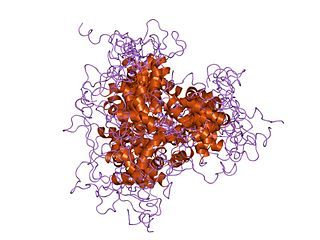
Howard Robert Horvitz ForMemRS NAS AAA&S APS NAM is an American biologist best known for his research on the nematode worm Caenorhabditis elegans, for which he was awarded the 2002 Nobel Prize in Physiology or Medicine, together with Sydney Brenner and John E. Sulston, whose "seminal discoveries concerning the genetic regulation of organ development and programmed cell death" were "important for medical research and have shed new light on the pathogenesis of many diseases".

Raymond Eugene Green is an American politician who served as the U.S. representative for Texas's 29th congressional district, serving for 13 terms. He is a member of the Democratic Party. His district included most of eastern Houston, including portions of the suburbs.
The short-stature homeobox gene (SHOX), also known as short-stature-homeobox-containing gene, is a gene located on both the X and Y chromosomes, which is associated with short stature in humans if mutated or present in only one copy (haploinsufficiency).

Desmoglein-3 is a protein that in humans is encoded by the DSG3 gene. In the skin epidermis Desmoglein-3 is expressed in the basal lower layers of the epidermis, and dominates in terms of expression on mucosal surfaces compared to Desmoglein-1.

C-X-C motif chemokine 11 (CXCL11) is a protein that in humans is encoded by the CXCL11 gene.

Somatostatin receptor type 1 is a protein that in humans is encoded by the SSTR1 gene.

Neurotensin receptor type 2 is a protein that in humans is encoded by the NTSR2 gene.

Homeobox protein Nkx-2.5 is a protein that in humans is encoded by the NKX2-5 gene.

Calcium-transporting ATPase type 2C member 1 is an enzyme that in humans is encoded by the ATP2C1 gene.

Homeobox D10, also known as HOXD10, is a protein which in humans is encoded by the HOXD10 gene.

ATP-binding cassette sub-family G member 5 is a protein that in humans is encoded by the ABCG5 gene.

Homeobox protein Hox-D13 is a protein that in humans is encoded by the HOXD13 gene. This gene belongs to the homeobox family of genes. The homeobox genes encode a highly conserved family of transcription factors that play an important role in morphogenesis in all multicellular organisms.

Paired box protein Pax-7 is a protein that in humans is encoded by the PAX7 gene.

Dolichyl pyrophosphate Man9GlcNAc2 alpha-1,3-glucosyltransferase is an enzyme that in humans is encoded by the ALG6 gene.

Homeobox protein Hox-C13 is a protein that in humans is encoded by the HOXC13 gene.

Kruppel-like factor 13, also known as KLF13, is a protein that in humans is encoded by the KLF13 gene.

Homeobox protein Hox-C9 is a protein that in humans is encoded by the HOXC9 gene.

Transcription factor HIVEP3 is a protein that in humans is encoded by the HIVEP3 gene.

Forkhead box D3 also known as FOXD3 is a forkhead protein that in humans is encoded by the FOXD3 gene.
Synthetic virology is a branch of virology engaged in the study and engineering of synthetic man-made viruses. It is a multidisciplinary research field at the intersection of virology, synthetic biology, computational biology, and DNA nanotechnology, from which it borrows and integrates its concepts and methodologies. There is a wide range of applications for synthetic viral technology such as medical treatments, investigative tools, and reviving organisms.











